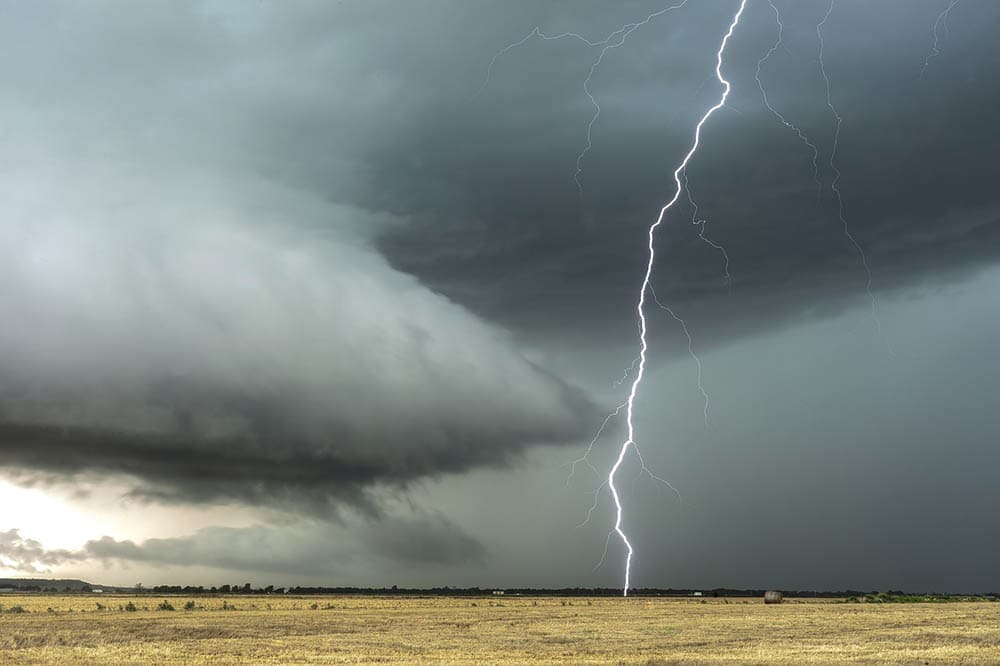How Loud Is Thunder in Decibels (dB)? With Noise Comparison Chart
-

- Last updated:

Everyone knows about the deadly power of lightning, but have you ever considered the potential damage of thunder? The sound of thunder registers around 100–120 dB when you’re within a few hundred feet of a lightning strike. That’s loud enough to cause significant hearing damage. Get too close, and thunder doesn’t just warn you of danger—it becomes a danger by itself!
If you’ve ever been curious about how loud thunder can get, we’ll break down what it can sound like at different distances.
 What Is Thunder?
What Is Thunder?
When lightning strikes, electricity releases intense heat as high as 50,000°F. That’s almost five times the temperature of the sun’s surface!
The sudden temperature increase around the lightning bolt creates a rapid expansion and contraction of air. That forceful movement causes the explosive thunderclap.
Lightning produces an initial shockwave in an approximate 30-foot radius around it. It’s a sonic boom created from air moving faster than the speed of sound. If lightning strikes within several feet of a structure, the resultant thunder can be strong enough to cause property damage. After the first several feet, the shock wave becomes a sound wave that you may hear in several ways, depending on the lightning strike’s distance from you and various weather-related factors.

How Loud Is Thunder in Decibels (dB)?
Within a few hundred feet of lightning, thunder will sound like an enormous bang of around 120 decibels. That’s equal to the sound of a jet taking off, a gunshot, or an ambulance siren. At close proximities, you may also hear hissing or clicking noises. These come from “upward streamers”—positive particles coming from the ground that discharge static electricity right before lightning strikes.
The sound of thunder dissipates and changes character as you move further away from it. Although it sounds like one massive clap up close, it sounds more like a long rumbling with several loud cracks from a distance.
Why Thunder Sounds Different from a Distance
So why does the sound of thunder change when you move away from a lightning strike? And why is there an extended rumbling noise?
The sound of thunder becomes lower-pitched as you get further away from it. The air scatters and absorbs the high-frequency sound waves first. You may hear a high-pitched crack up close, but not from a distance, as only the low-frequency waves travel that far.
The irregular rumbling is due to the long chain of thunder sounds coming from the lightning. Although it’s only about an inch wide, a lightning channel extends several miles, taking random zig-zagging paths from cloud to ground or from cloud to cloud. There’s a column of exploding air around it, producing thunder at every point along the channel.
You’ll first hear the thunder from the lightning point closest to you. Then, you will continue hearing it until the thunder from the lightning furthest from you finally passes by your ears.

What Factors Affect Thunder’s Volume?
Thunder won’t always be the same volume at a specific distance, as several weather-related factors can amplify or dampen it. A typical example is a temperature inversion in an elevated thunderstorm, which can occur in colder weather. In this situation, warm air over colder surface air traps the sound of thunder near the ground, causing it to refract and bounce, thus making it louder and longer-lasting.
Other factors that can dampen the volume and decrease the distance that the sound waves travel include precipitation, high humidity, and varied terrain. Under perfect conditions, you can hear the low rumbling of thunder as far as 30 miles away, but in most cases, you can only make it out within 10–15 miles of the lightning strike. In heavy rain, you may only notice it within a few miles.
How Thunder Can Harm Your Hearing
At close distances, the 120-decibel volume of a thunderclap can cause ear pain and damage your hearing. Permanent hearing damage can generally start at volumes above 85 decibels, but it requires a certain amount of exposure before it happens.
The louder the noise, the shorter the exposure time necessary to hurt your hearing. It takes roughly 8 hours of exposure to 85 dB noise to damage hearing, but you only need 15 minutes of exposure to 100 dB sound to suffer hearing loss. Although it’s over in seconds, the 120-dB intensity of nearby thunder can be enough to rupture your ear’s tympanic membrane and damage the delicate hair cells that transmit sound signals.

How to Calculate Thunder’s Distance
The sound of thunder travels roughly 1 mile every 5 seconds, so counting off the time between when you see a flash of lightning and when you hear the thunder can give you a rough estimate of how far you are from the lightning. Being able to estimate the distance is crucial for staying safe from lightning during a thunderstorm.
Many people recommend following the 30/30 rule for lightning safety. If it takes 30 seconds or less to hear the thunder from the time you see lightning (~6 miles away), then you should stay indoors. After the last sound of thunder dies away, wait 30 minutes before going back outside. Because lightning strikes are instant and unexpected, it’s essential to pre-plan by staying aware of weather forecasts for your area.
See also:
 Final Thoughts
Final Thoughts
There isn’t much you can do to protect yourself from the roar of thunder once lightning strikes. But appreciating its power can help you stay aware and prepared.
Within a few hundred feet of a lightning strike, the explosive force of thunder’s sound wave is around 120 dB in intensity. It can cause instant and permanent hearing damage. But by following the 30/30 rule and other practical safety measures, you can ensure you emerge unscathed from even the most extreme thunderstorms.
Featured Image Credit: Irina Kozorog, Shutterstock
Contents
 What Is Thunder?
What Is Thunder?